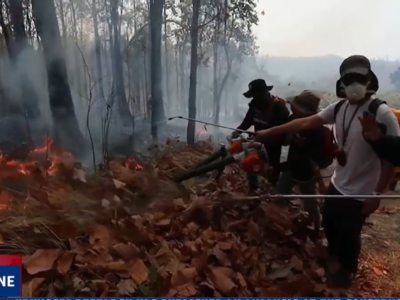
An Australian bushfire in 2019: Screenshot from ABC Four Corner video ‘Black Summer’ February 3, 2020
The Intergovernmental Panel on Climate Change's (IPCC) recent report declaration that we are facing a ‘code red for humanity’ should be no surprise. Millions have suffered during extreme weather events in recent years, and many have speculated about possible links between global warming and the annual increase in natural disasters.
Climate Change 2021: The Physical Science Basis (AR6 ) leaves no room for doubt that humans are behind the uptick in disasters, based on current science.
The IPCC’s analysis is quite clear. According to the AR6 Headline Statements from the Summary for Policymakers:
Human-induced climate change is already affecting many weather and climate extremes in every region across the globe. Evidence of observed changes in extremes such as heatwaves, heavy precipitation, droughts, and tropical cyclones, and, in particular, their attribution to human influence, has strengthened since the Fifth Assessment Report (AR5) in 2014.
Widespread observed and projected increases in the intensity and frequency of hot extremes, together with decreases in the intensity and frequency of cold extremes, are consistent with global and regional warming.
(AR6 Chapter 11.1.4 23)
Meteorologist Eric Holhaus agreed:
To me, the most important part of this week's big IPCC climate report is that science has now established a direct causal link between fossil fuel burning and extreme weather.
“climate change doesn’t just alter extreme weather — it changes everything.” https://t.co/eiOsvriv3p
— Eric Holthaus (@EricHolthaus) August 12, 2021
Since the 2019 United Nations Climate Change Conference, our planet has experienced numerous extreme weather events with increased frequency and intensity. Global Voice's video ‘Global Weather Disasters 2020–2021′ presents just a small fraction of those events. It includes droughts in Africa and North America; floods in Europe, China and India; and heatwaves and wildfires in Australia, North America and the Mediterranean.
According to the United Nations Office for Disaster Risk Reduction (UNDRR), overall climate-related disasters went up from 3,656 between 1980–1999 to 6,681 between 2000–2019 — an 83 percent increase.
Moreover, the World Meteorological Organization has concluded that: ‘A clear fingerprint of human-induced climate change has been identified on many of these extreme events’.
A number of scientific organisations have examined whether particular events can be attributed to the climate crisis. The Natural Hazards and Earth System Sciences (NHESS) journal examined the 2019–2020 Australian bushfires and identified ‘a connection between climate change and fire weather’:
…climate change has induced a higher weather-induced risk of such an extreme fire season. This trend is mainly driven by the increase of temperature extremes.
…we find that heat extremes have become more likely by at least a factor of 2 due to the long-term warming trend. However, current climate models overestimate variability and tend to underestimate the long-term trend in these extremes, so the true change in the likelihood of extreme heat could be larger, suggesting that the attribution of the increased fire weather risk is a conservative estimate.
Additionally, a World Weather Attribution study concluded ‘that the extreme rainfall and flooding caused by Tropical Storm Imelda [in Texas 2019] was made more likely and intense due to global warming’.
They also found that the 2020 Siberian heatwave ‘would have effectively been impossible without human-induced climate change’.
News outlets around the world are taking notice of the effects of climate change. The Guardian published a video snapshot at the beginning of August titled ‘NATURAL DISASTERS this week from 01-07 August 2021 Climate changе!’ which detailed the climate disasters from that week.
The AR6 report features an Interactive Atlas with in-depth regional data and projections such as: atmosphere and ocean temperatures, rainfall and sea-level increases. They include near-, medium- and long-term scenarios for 1.5, 2.3 and 4 degrees Celcius increases.
This image from the atlas shows temperature projections for the Mediterranean region based on a 2 degree Celcius increase scenario:
Vox has created a useful explanation of how to use the Interactive Atlas mapping tool. AR6 also created downloadable Regional Fact Sheets.
This Sky News UK twitter thread captures the extreme weather situation in mid-August 2021.
Here are the consequences of the extreme weather that’s happening around the world right now ???
?? In Turkey’s Black Sea region more than two dozen people have been killed after heavy rain caused floods and mudslides.
? Bozkurt, Turkey#DailyClimateShow
— Sky News (@SkyNews) August 13, 2021
The United Nations will consider climate change progress at the Glasgow COP26 Conference in November 2021. To see how your country's environmental commitments and action plan is rated, please visit Climate Action Tracker.
Thanks to Emma Lewis for her help in researching this story.







